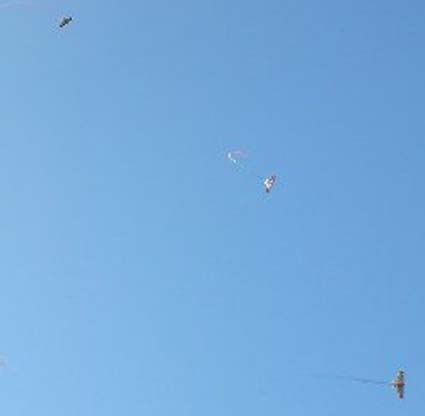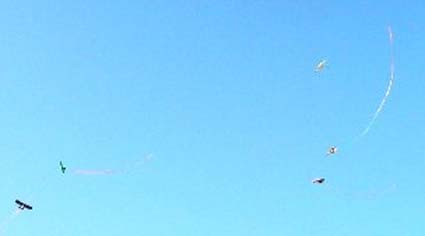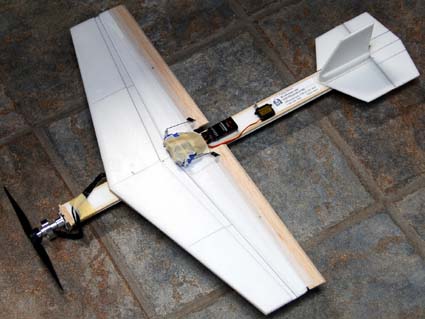 |
Flying High With Electric Power!
The Ampeer ON-LINE!
Fly the Future - Fly Electric! |
Site Table of Contents
| President: | Vice-President: | Secretary/Treasurer: |
| Ken Myers | Richard Utkan | Rick Sawicki |
| 1911 Bradshaw Ct. | 240 Cabinet | 5089 Ledgewood Ct. W. |
| Commerce Twp., MI 48390 | Milford, MI 48381 | Commerce Twp., MI 48382 |
| (248) 669-8124 | (248) 685-1705 | 248.685.7056 |
 | ||
| Board of Directors: | Board of Directors: | Ampeer Editor |
| David Stacer | Jack Lemon | Ken Myers |
| 16575 Brookland Blvd. | 8908 Sandy Ridge Dr. | 1911 Bradshaw Ct. |
| Northville, MI 48167 | White Lake, MI 48386 | Walled Lake, MI 48390 |
| 248.924.2324 | 248.698.4683 | 248.669.8124 |
| Mailed Ampeer subscriptions are $15 a year US & Canada and $20 a year world wide. FREE on-line! | ||
| The Next Flying Meeting:
Date: November 7 Time: 11:00 a.m. Place: Midwest RC Society 7 Mile Rd. Flying Field, Salem Twp., MI | ||
|
When subscribing to or renewing the paper version of the Ampeer, please make the check payable to Ken Myers. We do not have a DBA for the Ampeer or EFO. Thanks, Ken From Joe Hass Please check the Skymasters' Web site at www.skymasters.org for the latest information and flyer. Starting Tuesday, November 10, 2009
Lots of fun planned throughout the year. Many of the same sponsors have pledged to support us again. Joe Hass
Selecting Power Systems Hello Mr. Myers, I haven't been into flying for a while and now I'm slowly getting back into it. Last time I was into it, I had read some wonderful articles from your website written on how to determine a power system for a particular airplane, especially the ones written by Keith Shaw. Today, the technology for electrics has jump tremendously I think.
Derrick Longshore
Ken's Reply Yes, Keith's rules and formulas still work. The physics don't change. It is just a lot easier to hit the high end of the performance range today because of the lighter batteries and somewhat lighter motors. While it may not seem like it to many Ampeer readers, I try to use the "keep it simple stupid" (KISS) process to select power systems for my planes.
|
| Here is a table that relates prop pitch to RPM for pitch speeds between 50 mph and 85 mph. |
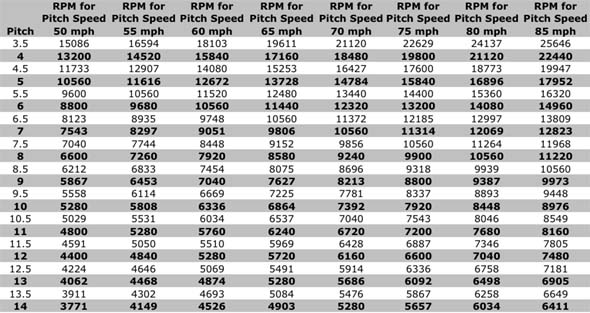
Table 1 - Prop Pitch/RPM/MPH
Click on chart to enlarge
| Since I prefer to use "A123" 2300mAh cells at about 100 watts in per cell, it makes figuring all kinds of things much easier.
Both the motor and airframe can be easily defined using the input watts that I am targeting. I use brushless outrunners, preferably Scorpion (www.innov8tivedesigns.com/), if they meet my criteria. Again, this is a matter of keeping it simple and sticking with one brand that I know works well and has plenty of trustworthy data available. You can use the Scorpion Motor Comparison Chart at innov8tivedesigns.com/Scorpion/Motor%20Comparison%20Web.htm or the brushless motor list at Progressive RC progressiverc.com/Brushless_Motor.html to help select motors that might be somewhat equivalent to the Scorpion outrunners if you prefer to experiment with other brands. For outrunners, I have a range of watts in per gram of motor weight that I use. I use about 1.75 watts in per gram of motor weight for the "heavy" end of my scale and 3 watts in per gram for the "lightest" motors that I would consider. My data shows that I mostly use about 2 watts in per gram of motor weight for my projects. While using this method suggests a motor towards the "heavier" end of the scale, it allows for a useful amount of nose weight, and the motor is running well within its limits for cool running and long life. Also, a larger, heavier motor is generally more efficient when turning the same prop from the same power source. Using 2 watts in per gram of motor weight makes selecting a motor much easier. I just divided the expected watts in by 2. For example, an outrunner for a 300 watts in system, for me, would weigh about 150g or about 5.3 oz. For the airframe, I've found that I like 60 watts in to 75 watts in per ounce of wing cube loading for monoplane sport and sport scale planes. A 300 watts in system has a maximum wing area of (60 watts in per oz. of CWL) 421 sq.in. and a minimum wing area of (75 watts in per oz. of CWL) 363 sq.in. The maximum ready-to-fly (RTF) weight is then easily calculated remembering that the heavy end of the sport CWL is 9.99. (Yes, 10 is okay - it is all relative). The maximum weight for a wing area of 421 sq.in. at 9.99 oz./cu.ft. is about 50 ounces and for a wing area of 363 sq.in. at 9.99 oz./cu.ft. it is about 40 ounces. I know that all of the math formulas I frequently give in the Ampeer drive folks nuts, so here is a chart. |

Table 2 - Wing Area and Weight Ranges
Click on chart to enlarge
| The following table shows the motor and prop combinations that I would consider for various "A123" 2300mAh packs. All of the props noted are APC brand except for the 10x8, which is a Master Airscrew standard wooden prop. The noted props are starting points that should pull about 35 amps at an elevation of 287m/940 ft. and 22-deg C/71-deg F. Higher elevations will require larger pitched props. Always use a power meter/watt meter to verify the amp draw of YOUR system. |

Table 3 - Motor Choices With Suggested Prop and Pitch Speed
Click on chart to enlarge
Putting Theory Into Practice
I have a winter project that I wish to purchase a power system for. The plane is a Bob Benjamin Classic 1989 Tigerkitten. If you are unaware of Bob and his designs, you should check out www.rcmodel.com. He was one of the first and best designers of airframes for electric power. The information on the Tigerkitten can be found at www.rcmodel.com/tiger/tigerk.html. I will be creating my model from a "new, unopened" ACE kit from the 1990's.
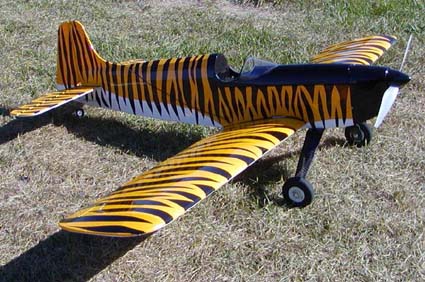 The photo shows EFO member and flying buddy Roger Wilfong's Tigerkitten. He carried through on the "Tiger" theme quite nicely.
With 450 sq.in. of wing area and a maximum CWL of 9.99, the maximum target weight is 55 ounces. At 55 ounces and with about 400 watts in the watts in per pound is about 116. That's good.
|

Table 4 - Data for my most recently completed planes
Click on chart to enlarge
| I also like to check to see how much "wiggle" room I might have with the completed airframe weight. I can use the table below to select components that I would use. |

Table 5 - Typical Component Weights
Once I've selected the components, I can subtract the power system and onboard radio components from the maximum target weight to get an approximate maximum airframe weight.

Table 6 - Maximum Target Airframe Weight While I believe that I can build the completed airframe, including a pilot bust and aileron extension cable at 27.5 oz. or less, it is nice to know that I have a couple ounces of "wiggle" room for those extra weights that creep into every build. If it is a glow plane, I check the glow plane's CWL based on the supplier's data to see if it is within the sport range. If the CWL does not fall within the sport range as a glow version, it won't as a conversion using "A123" 2300mAh cells. That does not mean that the model cannot be converted to an "A123" power system, just that it will not fly like a "sport" CWL plane.
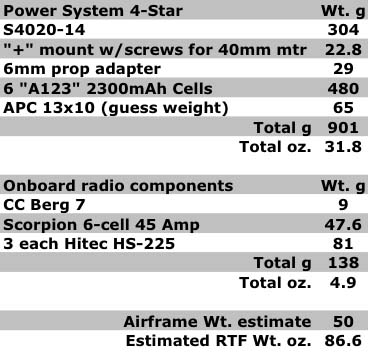
Table 7 - Estimate for a Sig 4-Star 40 kit conversion With a RTF weight of 86.6 oz, this 4-Star would have a CWL of 10, which is right on the cusp between "sport" and "advanced sport". I am pretty sure that I can build the airframe lighter than 50 ounces. (See Table 4) My 615 sq.in. Flite 40 ARF (www.rcgroups.com/forums/showthread.php?t=735972) has a completed airframe weight of 44.25 oz. and a RTF weight of 87.3 oz. giving it a CWL of 9.89 oz./cu.ft. ARF type glow planes are not noted for their lightweight airframes!
Horizon Hobby has created quite a few almost-ready-to-fly (ARF) planes designed specifically for electric power that have the designation "25e", as part of their names. They include, when powered by the E-Flite Power 25 outrunner, the Diamante 25e 485 sq.in. 57.6 oz. 9.32 CWL sport/precision aerobatic plane, T-34 Mentor 25e 545 sq.in. 80 oz. 10.87 CWL scale "trainer", Ultra Stick 25e 480 sq.in. 54.4 oz. 8.94 CWL sport plane, Pulse XT 25e 495 sq.in. 59.2 oz. 9.29 CWL sport low-wing and the DHC-2 Beaver 25e 565 sq.in. 78.4 oz. 10.08 CWL scale high-wing.
I have not had a biplane since my glow days in the 1980's. I used to fly an Airtronics kitted Acro Star bipe in IMAC competition and for fun, and I loved it. Why I have not added a bipe to my electric fleet, I do not know.

Horizon Hobby Photo I created a table for sport biplanes. |

Table 8 - Biplanes
Click on chart to enlarge
| The E-Flite Stearman PT-17 15e ARF has 608 sq.in. of wing area. Table 8 suggests that a 4S "A123" 2300mAh 400 watts in system would be appropriate. Table 3 implies that a SII-3026-710 weighing 205g would be a good choice. I would start with the APC 13x7 sport, since a biplane flies a bit more on thrust than using pitch speed when compared to a monoplane. Replacing the E-Flite Power 15 outrunner (152g) with the Scorpion SII-3026-710 outrunner (205g) increases the weight by 53g. Replacing the recommended 309g 3200mAh 3S 11.1V 20C LiPo with a 320g 4S "A123" 2300mAh pack increases the weight by another 11g for a total increase of 64g or 2.25 ounces.
Horizon Hobby gives the "heavy" weight as 3.8 lb. (60.8 oz.). With the addition of the heavier Scorpion motor and 4S "A123" 2300mAh pack, it should weigh about 63 oz. RTF. At 63 ounces it has a CWL of 7.26 oz./cu.ft. and about 102 watts in per pound. It should fly quite well. Whether this is the "best" way to select a power system when using "A123" 2300mAh cells, I don't know. This method has eliminated the math, and I hope that some folks find it useful when creating "sport" planes using systems based on the "A123" 2300mAh cells. I am missing several prop weights from the components table. If anyone can accurately weigh some of the "missing" props and get the information to me at kmyersefo@theampeer.org, I would appreciate it. It's Combat Time Several of the EFO members decided that it would be a lot of fun to fly combat. They built up some Fast and Furious foamies, attached streamers and had a ball. This is a fun and growing segment of our hobby. 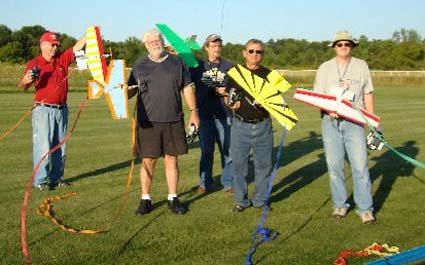
From Left to Right: Richard Utkan, Paul Sockow, Jim Maughan, Rick Sawicki, Dave Stacer
Three of the planes caught in action (top) & five (below)
New Planes from Carlos Reyes Based on the Modifly
I'm finalizing two new designs. The first is a small motorglider (ModiSoar), about 9 ounces and 60-inch wingspan. I get at least three vertical climbs to altitude on one battery pack.
The second is a mini pylon racer. 5.5 ounce flying weight, 20-inch wingspan. With flaps, it lands at close to the landing speed of ModiFly. Snap rolls are a lot of fun with it.
Carlos Reyes
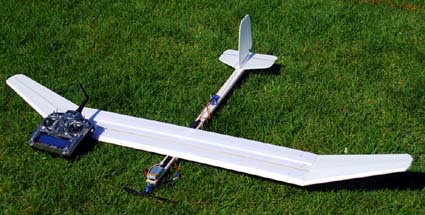 The October EFO Flying Meeting Friday, October 9 was a cool, gray, rainy day here in southeastern Michigan. All in all it was another unremarkable autumn day. My shoulder pain was up and down all day long, but I was looking forward to Saturday, when I would get my first chance to really get out of the house since my rotator cuff operation on September 18. Little did I know that Saturday was going to be one of the most uplifting days of my life.
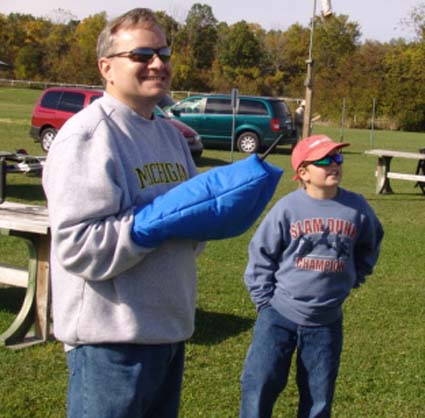
Jim Young and his new transmitter bag and Tim |
To Reach Ken Myers, you can land mail to the address at the top of the page. My E-mail
address is:
KMyersEFO@theampeer.org
EFO WEBsite:
